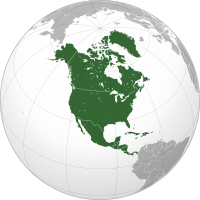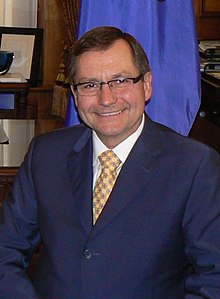Portal:North America
The North America Portal

North America is a continent in the Northern and Western Hemispheres. North America is bordered to the north by the Arctic Ocean, to the east by the Atlantic Ocean, to the southeast by South America and the Caribbean Sea, and to the west and south by the Pacific Ocean. The region includes the Bahamas, Bermuda, Canada, the Caribbean, Central America, Clipperton Island, Greenland, Mexico, Saint Pierre and Miquelon, Turks and Caicos Islands, and the United States.
North America covers an area of about 24,709,000 square kilometers (9,540,000 square miles), representing approximately 16.5% of the Earth's land area and 4.8% of its total surface area. It is the third-largest continent by size after Asia and Africa, and the fourth-largest continent by population after Asia, Africa, and Europe. As of 2021[update], North America's population was estimated as over 592 million people in 23 independent states, or about 7.5% of the world's population. In human geography, the terms "North America" and "North American" can refer to Canada, the United States, Mexico, and Greenland or, alternatively, Canada, Greenland and the US (Mexico being classified as part of Latin America) or simply Canada and the US (Greenland being classified as either Arctic or European (due to its political status as a part of Denmark) and Mexico classified as Latin American).
It is unknown with certainty how and when first human populations first reached North America. People were known to live in the Americas at least 20,000 years ago, but various evidence points to possibly earlier dates. The Paleo-Indian period in North America followed the Last Glacial Period, and lasted until about 10,000 years ago when the Archaic period began. The classic stage followed the Archaic period, and lasted from approximately the 6th to 13th centuries. Beginning in 1000 AD, the Norse were the first Europeans to begin exploring and ultimately colonizing areas of North America.
In 1492, the exploratory voyages of Christopher Columbus led to a transatlantic exchange, including migrations of European settlers during the Age of Discovery and the early modern period. Present-day cultural and ethnic patterns reflect interactions between European colonists, indigenous peoples, enslaved Africans, immigrants from Europe, Asia, and descendants of these respective groups. (Full article...)
The Grey Cup (French: Coupe Grey) is both the championship game of the Canadian Football League (CFL) and the trophy awarded to the victorious team playing in the namesake championship of professional Canadian football. The game is contested between the winners of the CFL's East and West Divisional playoffs and is one of Canadian television's largest annual sporting events. Since 2022, the game was held on the third Sunday of November. The Toronto Argonauts have the most Grey Cup wins (18) since its introduction in 1909, while the Edmonton Elks (formerly the Edmonton Eskimos) have the most Grey Cup wins (11) since the merger in 1958. The latest, the 110th Grey Cup, took place in Hamilton, Ontario, on November 19, 2023, when the Montreal Alouettes defeated the Winnipeg Blue Bombers 28–24.
The Grey Cup is Canada's largest annual sports and television event, regularly drawing a Canadian viewing audience of about 4 million. Two awards are given for play in the game: the Most Valuable Player and the Dick Suderman Trophy as most valuable Canadian player. In 2019, Andrew Harris was the first player to win both the Grey Cup's Most Valuable Canadian and Most Valuable Player the same year, playing for the Winnipeg Blue Bombers. (Full article...)

Edward Michael Stelmach ECA AOE (/ˈstɛlmæk/; born May 11, 1951) is a Canadian politician who served as the 13th premier of Alberta, from 2006 to 2011. The grandson of Ukrainian immigrants, Stelmach was born and raised on a farm near Lamont and fluently speaks the distinctive Canadian dialect of Ukrainian. He spent his entire pre-political adult life as a farmer, except for some time spent studying at the University of Alberta. His first foray into politics was a 1986 municipal election, when he was elected to Lamont County council. A year into his term, he was appointed reeve. He continued in this position until his entry into provincial politics.
In the 1993 provincial election, Stelmach was elected as the Member of the Legislative Assembly (MLA) for Vegreville-Viking (later Fort Saskatchewan-Vegreville). A Progressive Conservative, he served in the cabinets of Ralph Klein—at various times holding the portfolios of Intergovernmental Relations, Transportation, Infrastructure, and Agriculture, Food, and Rural Development—where he developed a reputation as a low-key politician who avoided the limelight. When Klein resigned the party's leadership in 2006, Stelmach was among the first to present his candidature to replace him. After a third-place finish on the first ballot of the leadership race, he won an upset second ballot victory over former provincial treasurer Jim Dinning. (Full article...)
Antonio Ezequiel Cárdenas Guillén (5 March 1962 – 5 November 2010), commonly referred to by his alias Tony Tormenta ("Tony Storm"), was a Mexican drug lord and co-leader of the Gulf Cartel, a drug trafficking organization based in Tamaulipas. He headed the criminal group along with Jorge Eduardo Costilla Sánchez. Antonio was considered by Mexican security forces as one of Mexico's most-wanted men.
Born in Matamoros, Tamaulipas, Antonio initially worked as a car washer at a local police station with his brother Osiel Cárdenas Guillén, former leader of the cartel. By the late 1980s, he entered the drug trade, and later became the crime boss of Matamoros, where he controlled the city's drug trafficking shipments and all organized crime activities. Few details were known of Antonio's criminal career prior to 1999, when his brother Osiel confronted federal agents at gunpoint with several of his gunmen in Matamoros. In 1998, Antonio avoided arrest after FBI and DEA agents tracked his whereabouts inside a domicile in Houston. Back in Mexico, his brother Osiel was the Gulf Cartel's main leader and had created a paramilitary squad known as Los Zetas, formed by soldiers who left the Mexican military. (Full article...)
Did you know...
- ... that Confederate General John W. Frazer surrendered the Cumberland Gap during the American Civil War without a fight?
- ... that tequila was first produced in the 16th century?
- ...that the word hurricane, used in the North Atlantic and Northeast Pacific, is derived from a native Caribbean Amerindian storm god, Huracan, via Spanish huracán?
- ... that the Chontal Maya of Tabasco consider themselves the direct descendants of the Olmec civilization?
- ...that Jacob Piatt Dunn in 1886 wrote the first scholarly history concerning the Indian Wars?
Selected panorama

Topics
Categories
List articles
Related portals
Northern America
Central America
Caribbean
WikiProjects
 North America
North America-
 Canada
Canada -
 Greenland
Greenland -
 Mexico
Mexico -
 Saint Pierre and Miquelon
Saint Pierre and Miquelon -
 United States
United States  Central America
Central America-
 Belize
Belize -
 Costa Rica
Costa Rica -
 El Salvador
El Salvador -
 Guatemala
Guatemala -
 Honduras
Honduras -
 Nicaragua
Nicaragua -
 Panama
Panama  Mesoamerica
Mesoamerica Caribbean
Caribbean-
 Antigua and Barbuda
Antigua and Barbuda -
 Bahamas
Bahamas -
 Barbados
Barbados -
 Bermuda
Bermuda -
 Cuba
Cuba -
 Dominica
Dominica -
 Dominican Republic
Dominican Republic -
 Grenada
Grenada -
 Haiti
Haiti -
 Jamaica
Jamaica -
 Puerto Rico
Puerto Rico -
 Saint Kitts and Nevis
Saint Kitts and Nevis -
 Saint Lucia
Saint Lucia -
 Saint Vincent and the Grenadines
Saint Vincent and the Grenadines -
 Trinidad and Tobago
Trinidad and Tobago
Associated Wikimedia
The following Wikimedia Foundation sister projects provide more on this subject:
-
Commons
Free media repository -
Wikibooks
Free textbooks and manuals -
Wikidata
Free knowledge base -
Wikinews
Free-content news -
Wikiquote
Collection of quotations -
Wikisource
Free-content library -
Wikiversity
Free learning tools -
Wikivoyage
Free travel guide -
Wiktionary
Dictionary and thesaurus


























